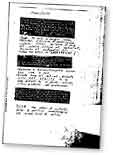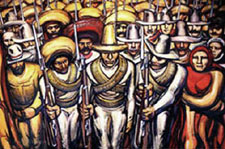manifestos
Design Justice
From Sasha Costanza-Chock, Design Justice: towards an intersectional feminist framework for design theory and practice:
"Design is key to our collective liberation, but most design processes today reproduce inequalities structured by what Black feminist scholars call the matrix of domination. Intersecting inequalities are manifest at all levels of the design process. This paper builds upon the Design Justice Principles, developed by an emerging network of designers and community organizers, to propose a working definition of design justice: Design justice is a eld of theory and practice that is concerned with how the design of objects and systems influences the distribution of risks, harms, and benefits among various groups of people. Design justice focuses on the ways that design reproduces, is reproduced by, and/or challenges the matrix of domination (white supremacy, heteropatriarchy, capitalism, and settler colonialism). Design justice is also a growing social movement that aims to ensure a more equitable distribution of design's benefits and burdens; fair and meaningful participation in design decisions; and recognition of community based design traditions, knowledge, and practices."
This is a great start.
Update, March 2020: Sasha turned this into a book! Design Justice: Community-Led Practices to Build the Worlds We Need
Update, August 2020: The book is now online.
First Things First 2014
On the 50th anniversary of the 1964 design manifesto, and in the spirit of its 2000 refresh, here is a 2014 update addressing the social impact of design in the digital age, below. I've added this to my growing list of design manifestos.
Design Manifestos 2010
I’ve added three new items to my growing list of design manifestos, all from 2010.
- January 2010: The Role of Design in the 21st Century, a manifesto and vision for the future of Danish design from the multidisciplinary Danish Design Association.
- September 2010: Anti-Design Festival Manifesto. Tomorrow the Anti Design Festival kicks off in the UK as a counter-event to the London Design Festival, both a protest against its “pretty commerciality” and attempt to “unlock creative fires and ideas, exploring spaces hitherto deemed out-of-bounds by a purely commercial criteria.”
- August 2010: The Obstructionist Manifesto. Mark Goldman writes against harmful, heavy-handed, insider-driven city planning.
100+ Years of Design Manifestos
 Since the days of radical printer-pamphleteers, design and designers have a long history of fighting for what’s right and working to transform society. The rise of the literary form of the manifesto also parallels the rise of modernity and the spread of letterpress printing.
Since the days of radical printer-pamphleteers, design and designers have a long history of fighting for what’s right and working to transform society. The rise of the literary form of the manifesto also parallels the rise of modernity and the spread of letterpress printing.
This list of design manifestos was buried in a previous post but deserves its own permalink. The original list was largely drawn from Mario Piazza’s presentation at the 2009 conference Più Design Può in Florence, though I’ve edited and added to it. I’ve also incorporated links where I was able to find them.
Manifesto del Sindicato de Obreros Tecnicos, Pintores y Escultores, 1922
Manifesto issued by the Union of Technical Workers, Painters, and Sculptors, 1922
“Social, Political, and Aesthetic Declaration from the Union of Technical Workers, Painters, and Sculptors to the indigenous races humiliated through centuries; to the soldiers converted into hangmen by their chiefs; to the workers and peasants who are oppressed by the rich; and to the intellectuals who are not servile to the bourgeoisie:
 We are with those who seek to overthrow of an old and inhuman system within which you, worker of the soil, produce riches for the overseer and politician, while you starve. Within which you, worker in the city, move the wheels of industries, weave the cloth, and create with your hands the modern comforts enjoyed by the parasites and prostitutes, while your own body is numb and cold. Within which you, Indian soldier, heroically abandon your land and give your life in the eternal hope of liberating your race from the degradations and misery of centuries.
We are with those who seek to overthrow of an old and inhuman system within which you, worker of the soil, produce riches for the overseer and politician, while you starve. Within which you, worker in the city, move the wheels of industries, weave the cloth, and create with your hands the modern comforts enjoyed by the parasites and prostitutes, while your own body is numb and cold. Within which you, Indian soldier, heroically abandon your land and give your life in the eternal hope of liberating your race from the degradations and misery of centuries.
Not only the noble labor but even the smallest manifestations of the material and spiritual vitality of our race spring from our native midst. Its admirable, exceptional, and peculiar ability to create beauty — the art of the Mexican people — is the highest and greatest spiritual expression of the world-tradition which constitutes our most valued heritage. It is great because it surges from the people; it is collective, and our own aesthetic aim is to socialize artistic expression, to destroy bourgeois individualism.
We repudiate the so-called easel art and all such art which springs from ultra-intellectual circles, for it is essentially aristocratic.
We hail the monumental expression of art because such art is public property.
We proclaim that this being the moment of social transformation from a decrepit to a new order, the makers of beauty must invest their greatest efforts in the aim of materializing an art valuable to the people, and our supreme objective in art, which is today an expression for individual pleasure, is to create beauty for all, beauty that enlightens and stirs to struggle.”
David Siqueiros, et al., originally published as a broadside in Mexico City, 1922. Published again in El Machete, no. 7 (Barcelona, June 1924).
English translation from Laurence E. Schmeckebier Modern Mexican Art (Minneapolis: University of Minnesota, 1939), p. 31.
First Things, Again
In 1964, a group of London designers published a a manifesto, a challenge to designers involved to apply their skills to worthwhile purposes. In 2000, “First Things First” was updated and published in 7 design magazines. It provoked a bit of debate.

